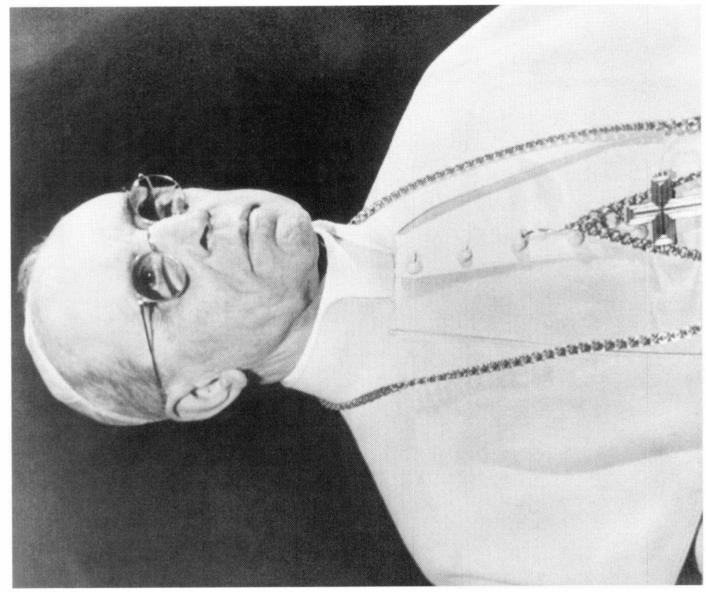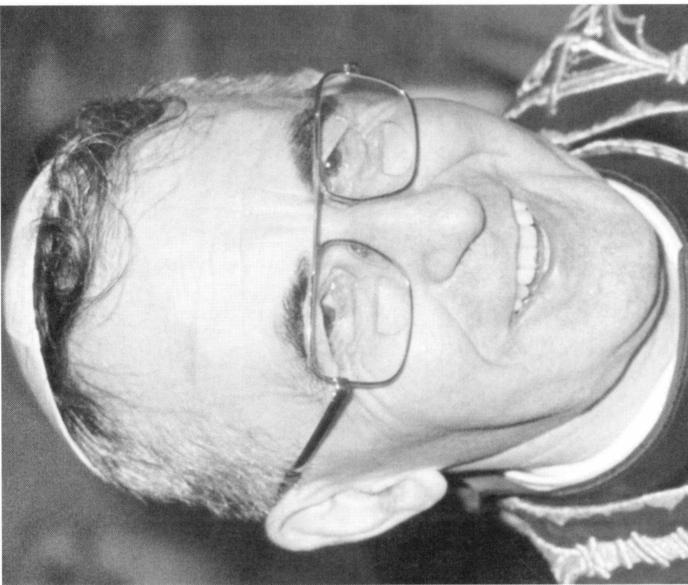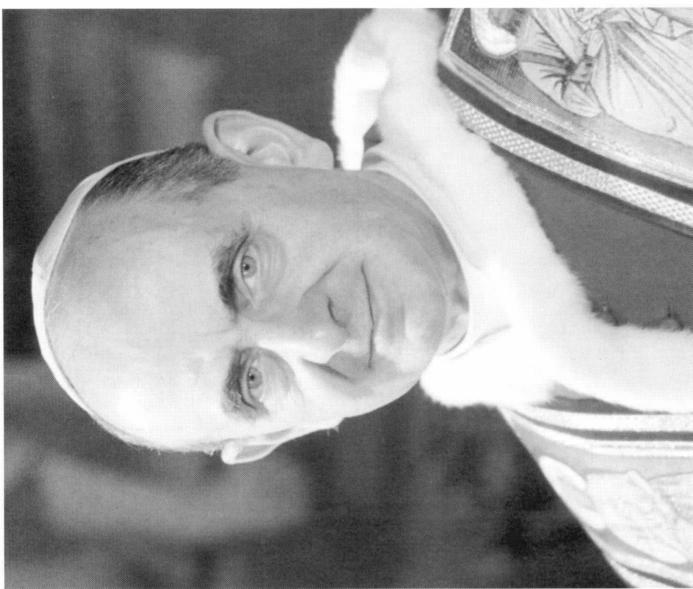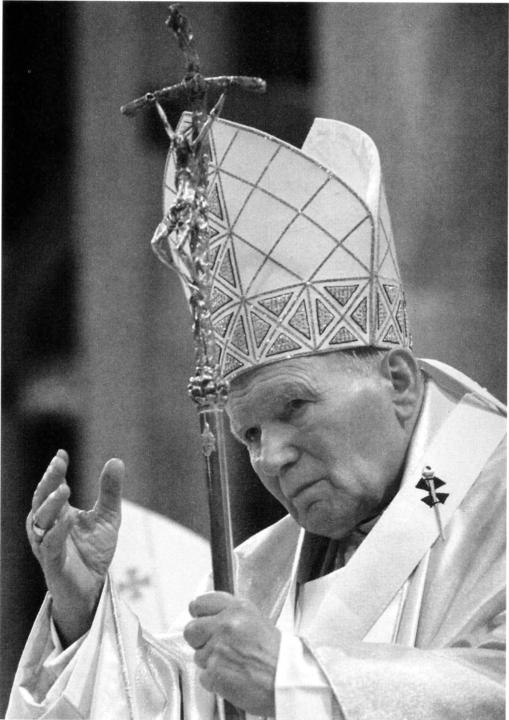The Vatican Exposed: Money, Murder, and the Mafia (23 page)
Read The Vatican Exposed: Money, Murder, and the Mafia Online
Authors: Paul L. Williams





Karol Wojtyla, Pope John Paul II. (Photo from Catholic News Service.)
In September 1976 the Italian authorities finally succeeded in
having Sindona arrested in New York. In the company of his friends
and supporters, Sindona expressed shock, surprise, and profound displeasure that "the United States chose now, some two years after
these false charges were lodged against me in Italy, to begin these
extradition proceedings, I want to emphasize that the charges were
made in Italy on the basis of little or no investigation, and, on their
face, are false." The Shark was booked in New York Criminal Court,
detained in a holding cell, and released on $3 million bail.
Sindona and the Genovese family employed every means at their
disposal to ward off the extradition. Fund-raising events for Sindona's legal defense were held throughout Little Italy. Unfortunately,
the family members, being thieves, neglected to turn over all the proceeds from such dinners and banquets to Sindona's team of lawyers.
Rather they skimmed 50 percent off the top for themselves.15
Distinguished individuals were used to plead for the Shark in
court. Carmelo Spagnuolo, president of the Supreme Court in
Rome, swore that the charges against the Sicilian were part of a Communist plot to undermine leading industrialists of Italy. He claimed
left-winged extremists within Italy's judiciary had devised the plot
and that Sindona-"a great protector of the working class"-would
be killed as soon as he arrived on Italian soil." Spagnuolo's testimony
was supported by Licio Gelli, who told the court: "The Communists'
hatred of Michele Sindona is due to the fact that he is an anti-Communist and that he has always been favorable to the free enterprise
system in a democratic Italy. 1117
Michele Sindona may have been wanted by law enforcement officials in Italy and welcomed by the Mafia in America, but the bronze
doors to the Holy See were now closed to him. As Italian investigations
uncovered "the Vatican connection," Paul VI became a subject of
scorn and derision. Stories appeared in the press that the Holy Father
had lost up to $1 billion because of his clandestine dealings with the
Mafia. On the left of the theological spectrum, the Jesuits attacked the pope for his interference in Italian politics and his placement of "the
Church's future in the hands of Satan." On the right, Tridentine conservatives, including French Archbishop Marcel Lefebvre, demanded
Paul VI's abdication. The Traditionalist, a Catholic weekly newspaper,
after publishing a detailed account of the Sindona affair in February
1973, called the pope "a traitor to the Church."
Bishop Marcinkus was forced to submit to the indignity of intensive questioning by Italian officials about his transactions with Sindona on a personal basis and as a representative of the Vatican.
Marcinkus performed as expected. In April 1973 he had said to U.S.
investigators: "Michele and I are very good friends. We've known
each other for many years." Two years later, when questioned by the
Italian magazine L'Expresso, Marcinkus said: "The truth is that I
don't know Sindona. How can I have lost money because of him?"
Pope Paul VI fell into a purple funk. His behavior became erratic.
He spoke with his confidants about the possibility of resigning.
Before he would agree to set aside the tiara, the pope said that he
would have to make amends for the financial loss he had caused the
Church. He wished to retain the right to name his successor, and he
requested the abolishment of the four-hundred-year-old decree that
prohibited popes from selling their sanctified positions as vicars of
Christ to the highest bidders among the cardinals.18 This would
permit him to raise a fortune for Holy Mother Church-the fortune
he had lost due to his dealings with the Mafia.
The pope complained of loss of sleep. He wandered through the
corridors of the Lateran Palace in the wee hours of the morning,
often complaining of an ominous presence within the Holy See. "The
smoke of Satan has entered the Church. It is around the altar," he
told his attendants.'9
At last the Holy Father regained his senses. He knew how to
overcome the problems. He would permit Bishop Marcinkus to make
a new and better deal-this time with Sindona's replacement as a
financial capo for the Mafia and paymaster to P-2-with Roberto
Calvi, the president of Banco Ambrosiano.
However, Roberto Calvi wasted no time involving the Vatican in
one shady business scheme after another. On November 19, 1976, Calvi acquired 53.3 percent of Banco Mercantile of Florence on
behalf of the Vatican Bank. On December 17 the shares were conveyed to the Milan brokerage film of Giammei and Company. By
sleight of hand, the shares became "parked" that same day at the Vatican Bank. But there was a problem. The Vatican did not have sufficient funds in the account where the shares had been transferred.
This problem was solved by the creation of a new account with a
sudden and rather miraculous credit balance of 8 billion lire (over
$10 million). Six months after these strange transactions, on June 29,
1977, Giammei and Company bought back the shares through a firm
called Credito Commerciale of Milan. At this point, Calvi, on behalf
of his firm Immobiliare XX Settembre, purchased the bank stock
from Credito Commercial.
It was a dazzling shell game. Every time the shares changed
hands, they displayed a dramatic increase in value. The original value
of the Banco Mercantile stock had been 14,000 lire per share. On
June 29, when Credito Commerciale sold the shares to Calvi, its
value had increased to 26,000 lire per share.20 By selling himself
shares he already owned at twice the original price, Calvi artificially
increased the value of the bank stock. The shares of Banco Mercantile now seemed the hottest items on the Milan stock exchange. This
permitted Calvi to unload the bloated stock to Anna Bonomi, a business rival, for 33 billion lire ($40 million). For the privilege of using
the Vatican's name and facilities in this scheme, Calvi graciously provided a kickback of 800 million lire to the Vatican Bank.21
The Banco Mercantile was one scheme among many. The Vatican
Bank began to earn huge annual payments from Calvi for its willingness to engage in fraudulent ventures. The papal coffers once more
were being filled to overflowing. But in August 1978 the cash flow
suddenly stopped. Pope Paul VI died of a heart attack at Castel Gandolfo and his successor-Albino Lucian, who called himself Pope
John Paul I-issued a call for reform.